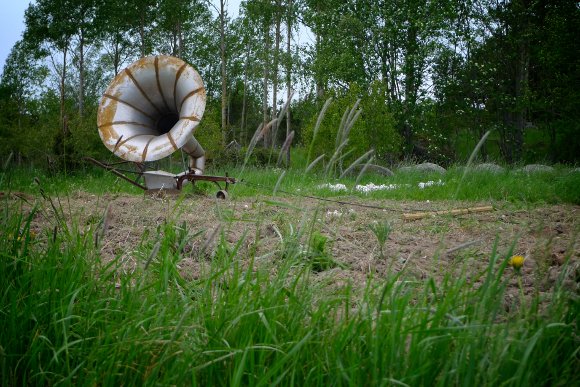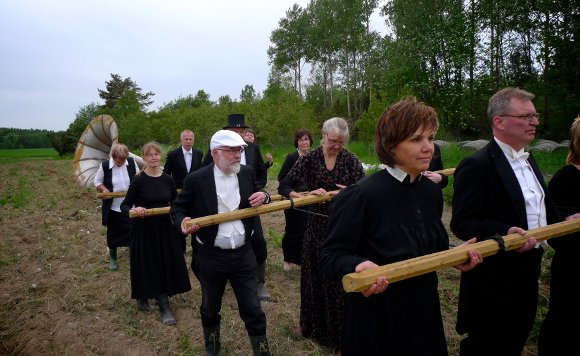If you think culture has become too disconnected from the Earth, “Harvest” and the Terrafon instrument surely count as a shock to the system. A traditional ensemble picks up an enormous tone arm and transducer and, through back-breaking labor, drag it across arable fields. It’s part sound art and performance, part agriculture. But it certainly counts as a gramophone – it’s just a really big one that reads the grooves of the earth.
Beat juggling with two of these I’m guessing is largely out of the question.
One half of the artistic creative team, Olle Cornéer, writes with a description:
Harvest (2009) is a new art piece for the new instrument terrafon, traditional ensemble and cropland – by Olle Cornéer and Martin Lübcke.
In this performance Alunda Church Choir, conducted by Cantor Jan Hällgren, plays the soil of northern Uppland (in Sweden) on terrafon. Harvest by Alunda Kyrkokör was exhibited at the Volt Festival in Uppsala the 6th of June 2009. Terrafon is a large agricultural version of the horn gramophone, amplifying the sounds in the track it ploughs.
There is more to come. There are still many croplands still untouched by terrafon. The only thing needed is a powerful local musical ensemble that can sweat it out. This is indeed a demanding piece.
Video illustrates what this all means in practice:
Harvest by Alunda Kyrkokör (2009) from Olle Corneer on Vimeo.
The artistic duo behind the work is a fascinating collaboration. Olle is a producer and musician, while partner-in-crime Martin Lübcke has a PhD in theoretical physics, specializing in superstring theory. That has been the grounds on which their other work, Bacterial Orchestra, explores ideas both of biological epidemics and multi-celled organisms and neural networks. Of course, to make it truly multi-celled, they’ve made the piece an iPhone creation. (I think some folks have found the iPhone phenomenon to be viral as is, so this seems somewhat appropriate.)
Public Epidemic No 1 from Olle Corneer on Vimeo.
Every cell listens to its surroundings and picks up sounds, trying to play together in a musical way. The musical material comes from the background noise, people talking or sounds played by other cells.
Every cell has a unique DNA. Only the ones that are musical fit enough survives. If
the surroundings doesn’t meet up to its conditions – too noisy, too quiet or no distinct
pulse – the cell dies and is reborn with a new, hopefully better, set of DNA.The result is a musical organism adapting to and changing its environment, growing and evolving with other cells and spectators.
More on that piece:
http://www.bacterialorchestra.com
It’s nice to me that, while these works are both conceptual, you might not guess they came from the same team. I wonder what will come next.

